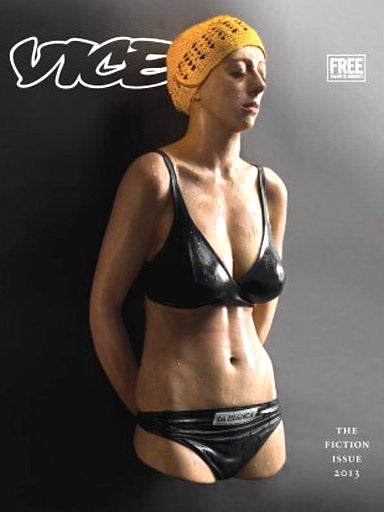The media must inform about suicide, while avoiding excessive details about the method
Reporting on suicide is extremely difficult, but the Vice feature is an example of glamorising suicide - and there wasn't even a news hook


Your support helps us to tell the story
From reproductive rights to climate change to Big Tech, The Independent is on the ground when the story is developing. Whether it's investigating the financials of Elon Musk's pro-Trump PAC or producing our latest documentary, 'The A Word', which shines a light on the American women fighting for reproductive rights, we know how important it is to parse out the facts from the messaging.
At such a critical moment in US history, we need reporters on the ground. Your donation allows us to keep sending journalists to speak to both sides of the story.
The Independent is trusted by Americans across the entire political spectrum. And unlike many other quality news outlets, we choose not to lock Americans out of our reporting and analysis with paywalls. We believe quality journalism should be available to everyone, paid for by those who can afford it.
Your support makes all the difference.Occasionally it is said there is no such thing as a bad idea. Wrong.
People come up with absolute shockers quite frequently but they rarely make it past the first page of the real or metaphorical flip chart. Insofar as newspapers and magazines are concerned, derisive howls from desk editors stop most stinky proposals in their tracks.
But from time to time, the bad idea becomes a very shocking reality, as has been demonstrated this week by the appearance in Vice magazine of a fashion feature which amounted to a deeply unsettling smorgasbord of death by suicide. It is undoubtedly one of those occasions when the collective eyebrow of the reading public is raised to the sky and it is widely wondered what the bloody hell the editor was thinking.
In its striking lack of taste it put me in mind of one of the more egregious cases that crossed my desk during ten years at the Press Complaints Commission. A real life magazine ran a feature about a woman who had escaped the clutches of a violent partner, only to see him move onto a new victim, who he subsequently killed. This story was grim enough but a bright spark had the cracking idea to mock up a picture of how the body of the deceased may have looked when discovered. One trainee-journalist-sprawled-on-the-floor-covered-with-bin-bags later and a gross intrusion into the grief of the dead woman's family was complete. The fact that the item appeared almost exactly at the first anniversary of her death was presumably coincidental. Either way, thumbs up all round.
As for coverage of suicide, the closest parallel to the Vice feature I can think of is a case which also came to the PCC, this time involving a 'news' item in the Daily Sport headlined 'The Top Yourself 10' - a jolly rundown of the top ten suicide hotspots in Britain, based on a rather dryer police report.
While the article was shocking, it allowed the PCC for the first time to uphold a complaint under a clause of the Editors' Code of Practice which had been introduced in 2006:
“When reporting suicide, care should be taken to avoid excessive detail about the method used.”
In its ruling against the Daily Sport - Vice take note - the PCC concluded that:
“The problem with this case was that it was an entirely gratuitous guide to where individuals have killed themselves, and explicitly pointed out to people that there were a number of options about how and where to attempt suicide. This was clearly excessive in the context. The Commission was also concerned that the light-hearted presentation of the piece…may have glamorised suicide in the eyes of some readers. As the Code is designed to minimise the chances of imitative suicides, this was a further breach of the Code.”
The Press Complaints Commission had started to take an increasing interest in the reporting of suicide following the media’s response to an unusually high number of suicides in and around Bridgend in 2007/08. The then Chairman, Sir Christopher Meyer, travelled to South Wales to meet families and local authorities. PCC staff began to work closely with Bridgend’s MP Madeleine Moon and with relevant charities (notably Samaritans and Papyrus) and academics.
Evidence about the potential for ‘copycat’ suicides is strong. The ‘Werther effect’, so-named after the central character in Goethe’s novel ‘The Sorrows of Young Werther’, can result from both fictional and factual representations of suicide in any medium – and has been discerned in a variety of instances. It has occasionally been put to me that a reported method is so gruesome that surely nobody in their right mind would want to copy it. But of course that is rather the point: the large majority of people who take their own lives are suffering from an unbalanced state of mind at the time.
Nevertheless, suicide can be newsworthy and the media faces a challenge to balance the imperative to inform – especially when a suicide happens in a public place – and the need to avoid excessive details about method and the possibility of glamorising the act. The apparent double suicide of two teenagers, who were hit by a train in Hertfordshire on Monday, is a case in point.
On the whole, reporting in this area has improved considerably in the last five years, and the shock that greeted the Vice’s fashion feature is indicative of that. Yet it is also a reminder of the continued need for care, not only in contemporaneous reports of specific incidents but also in the context of material that has no news hook whatsoever.
www.samaritans.org; 08457 90 90 90 (UK) 1850 69 90 90 (Ireland)